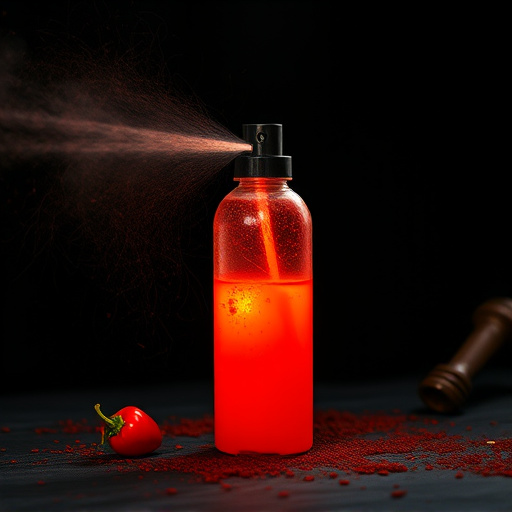TL;DR:
Neutralizing pepper spray on the face involves immediate actions like removing trapped clothing, rinsing with water, and using specialized neutralizing agents. Key steps include spraying from 2-3 feet away in short bursts, targeting eyes, nose, and mouth, while wearing protective gear and ensuring proper ventilation to avoid collateral damage. Regular maintenance of spray devices and knowledge of local laws are crucial for effective personal protection against pepper spray.
“Protecting yourself from inflammatory agents, particularly pepper spray, requires a deep understanding of its effects on the face and the right tools for neutralization. This article delves into the science behind pepper spray, focusing on its impact on facial skin. We explore the critical role of neutralizing agents in personal protection and uncover the key active ingredients that make a spray effective. Learn best application techniques to ensure optimal protection against pepper spray and understand essential safety measures before using these protective sprays.”
- Understanding Pepper Spray and Its Effects on the Face
- The Role of Neutralizing Agents in Personal Protection
- Active Ingredients in Effective Personal Protection Sprays
- Application Techniques for Optimal Protection Against Pepper Spray
- Safety Measures and Precautions When Using Personal Protection Sprays
Understanding Pepper Spray and Its Effects on the Face
Pepper spray, an inflammatory agent designed for personal protection, is a powerful tool that can quickly disable an attacker. When sprayed into the eyes and face, it triggers a burning sensation and temporary blindness, giving the user valuable time to escape. The active ingredient in pepper spray, capsaicin, disrupts nerve signals, causing inflammation and pain. This reaction is what neutralizes the threat, allowing the victim to regain control of the situation.
Knowing how to neutralize pepper spray on the face is crucial for anyone considering carrying such a device. After exposure, immediate actions like removing any clothing or accessories that may trap the spray near the eyes and face, and thoroughly rinsing with water can help alleviate symptoms. Using neutralizing agents designed specifically for pepper spray can also reduce its effectiveness and discomfort. In cases of severe irritation or difficulty breathing, seeking medical attention is essential.
The Role of Neutralizing Agents in Personal Protection
In the realm of personal protection, especially against inflammatory agents like pepper spray, neutralizing agents play a pivotal role. These specialized substances are designed to counteract the effects of irritants, offering a crucial layer of safety for individuals facing potential attacks. When pepper spray comes into contact with the face or eyes, it stimulates these sensitive areas, causing pain and temporary blindness. Neutralizing agents act swiftly to disrupt the chemical reaction, breaking down the active ingredients in pepper spray and alleviating symptoms.
By neutralizing the irritants, these agents enable individuals to regain clear vision and reduce discomfort more rapidly. This is particularly important in high-stress situations where every second counts. Effective neutralizing solutions often contain specific chemicals that interact with the components of pepper spray, rendering it harmless. Thus, understanding the role of these neutralizers is essential for anyone looking to enhance their personal protection strategy, especially when facing potential exposure to inflammatory agents like pepper spray on the face.
Active Ingredients in Effective Personal Protection Sprays
Personal protection sprays are an essential tool for individuals seeking to defend themselves against inflammatory agents, including pepper spray. The key to their effectiveness lies in the active ingredients they contain, which are designed to neutralize and dissipate the harmful effects of such irritants. One of the primary active components is capsaicin, a compound derived from chili peppers. When used in personal protection sprays, capsaicin acts as a natural irritant that disrupts the body’s pain receptors, making it an effective deterrent against pepper spray attacks.
Additionally, many modern personal protection sprays incorporate other potent ingredients like oleoresin capsicum (OC) and P-benzoquinone imine (PBQI). OC is known for its strong infrared heat absorption properties, which enhance the neutralizing effect of capsaicin by further aggravating the attacker’s eyes and respiratory system. Meanwhile, PBQI amplifies the pain response, ensuring a swift and powerful reaction to deter aggressors. These active ingredients work synergistically to provide users with a robust defense mechanism, offering peace of mind in potentially dangerous situations, especially when it comes to neutralizing pepper spray on the face.
Application Techniques for Optimal Protection Against Pepper Spray
When applying a neutralizing spray for pepper spray, timing and technique are crucial for optimal protection. It’s recommended to keep the spray bottle at arm’s length and target areas like the eyes, nose, and mouth—common entry points for irritants. A swift, even misting is key; aiming for a distance of approximately 2-3 feet ensures coverage without risking inhalation of the spray.
For best results, apply the spray in short bursts, allowing each mist to settle before repeating. This technique helps prevent excessive inhalation and maximizes the neutralizing effect. Remember, rapid deployment is critical; immediately after sensing pepper spray, act swiftly by spraying liberally and moving to a safe distance until the stinging sensation subsides.
Safety Measures and Precautions When Using Personal Protection Sprays
When using personal protection sprays, such as those designed to neutralize pepper spray on the face, it’s paramount to prioritize safety. Always wear protective clothing, including gloves and eye gear, to minimize direct contact with the spray. Ensure proper ventilation in the area to prevent inhalation of irritants. Keep a safe distance from the target and bystanders, aiming for vulnerable areas like the eyes and nose to neutralize the threat effectively while minimizing collateral damage.
Regularly maintain and inspect your spray device to guarantee its functionality. Store the spray in a secure location, out of reach of children and unauthorized individuals. Familiarize yourself with local laws and regulations governing the use of personal protection sprays, as they can vary significantly. In case of accidental exposure or if the spray comes into contact with your face, have eye wash or a neutralizing solution readily available for immediate treatment.
